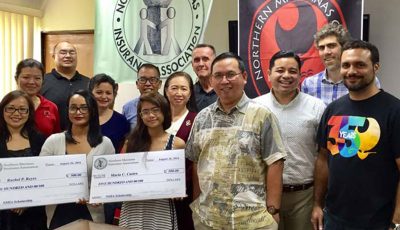Sustained drop in Japan arrivals worries industry
Tenorio: CNMI will not lose Japan market
Despite the consistent increase in visitor arrival numbers in the last few months, the tally coming from the CNMI’s original source market, Japan, is dropping at a fast clip. Marianas Visitors Authority managing director Perry Tenorio said that tourism stakeholders are keenly aware of the drop and are all working to rebuild the market.
Historically, Japan was the first market that the CNMI relied on for its tourism industry. In the last few months, though, South Korea and China have taken over as the top source markets for the CNMI.
Although total arrivals have increased 16 percent, according to MVA’s latest release for monthly arrivals, Japan fell by 15 percent to just 7,023 visitors last month.
According to MVA data, arrivals from Japan in 2011 comprised 44 percent of the CNMI’s total arrival numbers. In 2012, this went down to 38.6 percent. It then declined further in 2013 to 34.2 percent and drastically dropped to 25.8 percent in 2014.
Despite these historic drops in the Japanese market, Tenorio assured that “CNMI will not lose the Japan market.”
“It continues to remain a very important source country. There is an immediate need, however, to rebuild the Japan market so as to boost up arrivals,” Tenorio said.
He said they did have a major meeting here on Saipan on Dec. 4 between key Japan travel agents and the CNMI’s tourism players as well as officials of the administration to discuss how to boost Japanese arrivals.
Tenorio said they have three of these kinds of meetings a year to develop new strategies and approaches.
Factors affecting Japan market
According to Tenorio, many factors contribute to the decline in Japanese arrivals. One such factor is the increase in Japan’s consumption tax from 5 percent to 8 percent in April 2014, resulting in Japanese consumers being more cautious about spending for overseas travel.
A second factor is the quick depreciation of the Japanese yen from 78 to 118 yen to the dollar today, which makes travel to dollar-based destination like the CNMI 51 percent more expensive than it used to be just a few years ago.
Another factor is that Japan has seen the launch of low-cost carriers over the last few years that are offering incredibly cheap flights to destinations like Malaysia or Bali for under $100 or even under $50 one-way.
“These predatory pricing are pulling Japanese visitors away from the CNMI than it used to be just a few years ago,” Tenorio said.
These factors, coupled with a weak Japanese economy, means the Japanese are spending much less or are being very economical on travel than before. Additionally, research from April this year has shown that 70.1 percent of Japanese are reducing their spending on overseas travel, according to Tenorio.
Another reason is the drop in airlift.
“While the CNMI is enjoying additional lift from Korea and China over the past several years, there has been no new airlift from Japan. As compared to service that we used to have from Tokyo, Nagoya and Osaka, we now only have Delta service from Tokyo on a regularly scheduled basis and seasonal charters from secondary cities during peak season,” he said.
He said another factor is the travel agents’ inability to secure hotel accommodations on the island.
“This is especially difficult during the peak seasons, given the rapid increase in arrivals from Korea and China,” he said.
What is the next step?
According to Tenorio, stakeholders are well aware of the drop in Japanese arrivals and are working to rebuild the market.
He noted five ways to rebuild the market again. They are:
Targeting new low cost airlines to launch service from Japan to the CNMI.
Re-branding the CNMI in Japan as the “Flower Islands” and “Sports Islands.”
Launching promotions including TV commercials to promote this new branding in Japan.
Working to develop more local events like another Night Market or the Flower Island developments, which will appeal to the Japan market, as well as other markets; and
Launch new training/educational programs for Japanese travel agents to emphasize the new hotel developments coming into the pipeline.
Impact
Japan, Korea, and China account for over 90 percent of total arrivals to the islands and estimates to have generated approximately $970 million in economic activity for the CNMI in fiscal year 2014.
According to Tenorio, a tourist from Japan who travels to the CNMI generates a total impact of $2,565 per person. An example would be last month’s arrival, where the total impact from the Japan market is estimated at $18 million.
“Despite the aforementioned challenges, the MVA in collaboration with its Japan partners are actively looking at ways to boost Japan arrivals,” Tenorio said.



























